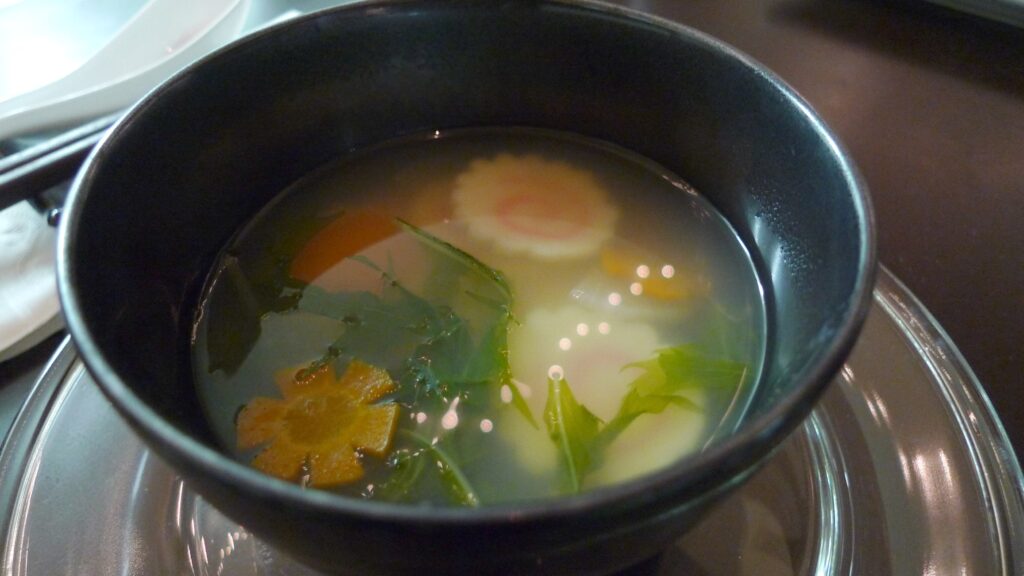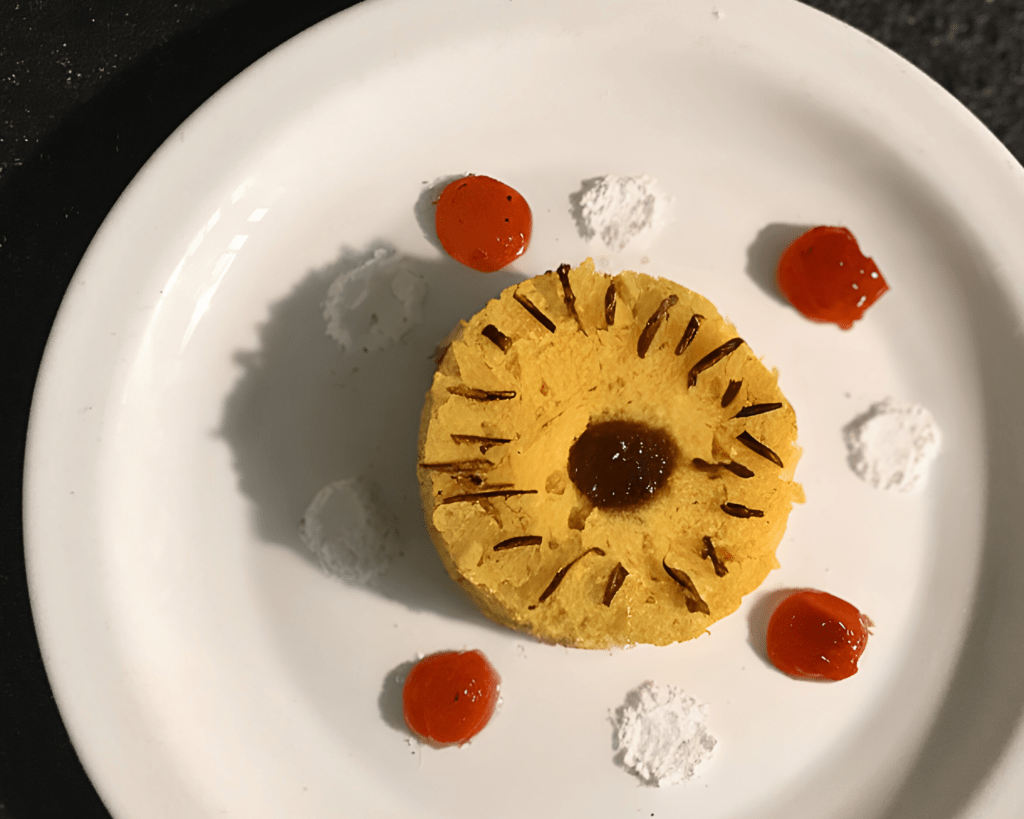There’s a lot to love about this time of year—festive gatherings, the nostalgia of Elf playing in the background, Christmas lights—but holiday meals might top the list. And while there’s always a place for some eggnog, peppermint bark, and gingerbread, why not try something new this year?
If you’re looking for new recipes, there’s no better place to turn than Berkeley’s International House. Founded in 1930 as a haven for cultural exchange during a segregated era, I-House has welcomed students and scholars from more than 85 countries ever since. No surprise, then, that the historic residential center has become a place of shared passion for global cuisine.
At weekly events, residents come together to sample a rich and ever-changing array of international dishes and snacks. As resident Eryn Su wrote, “Living at I-House is like taking a food tour around the world.” In fact, since 2021, I-House has published an annual cookbook, featuring favorite recipes from its chefs and residents.
We asked I-House alumni and residents for some end-of-year-inspired recipes from their home countries. The following six dishes range from quick and simple, like a fresh Tunisian salad and a buttery Réunion Island dessert, to slow-cooked classics, such as Singapore’s Hainanese Chicken Rice and a hearty Malagasy soup. Bon appétit!
1. Ozoni (Traditional New Year’s Soup)

Japan
Start to finish: 30-45 mins
2-3 servings


“Kanto-style ozoni is a dish deeply tied to Japan’s New Year traditions, symbolizing family, renewal, and good fortune. The simplicity of the clear dashi broth and the symbolic ingredients—like mochi representing strength and longevity—reflect the essence of Japanese culture. Each region in Japan has its own version of ozoni, showcasing local diversity, but this recipe highlights the flavors of the eastern region, where I grew up.
My mom taught me how to make Japanese traditional Ozoni. Every New Year’s morning, my family gathers to enjoy it. [It’s] a comforting dish that symbolizes togetherness and tradition. I loved helping toast the mochi and arrange the ingredients, making it a special part of our celebration. Even now, ozoni reminds me of those cherished moments with my family.” -Inosuke Yamada ’25
Ingredients
- 2 mochi (each about 2-3 inches square)
- 2 cups dashi (Japanese soup stock, available in Asian markets, or use chicken/vegetable broth as an alternative)
- 1 tbsp soy sauce
- 1 tbsp sake
- 1/2 tsp salt (adjust to taste)
- 2 slices chicken breast or thigh (optional)
- 1 small carrot (thinly sliced; optional: decorative shapes like flowers)
- 1 handful (about 1 cup) spinach or komatsuna (Japanese mustard spinach, blanched and chopped)
- 2 slices kamaboko (fish cake)
- Yuzu peel or chopped green onion (optional, for garnish)
Directions
1. Prepare the Dashi Broth
- In a small pot, bring 2 cups of dashi to a gentle simmer.
- Add 1 tbsp soy sauce, 1 tbsp sake, and 1/2 tsp salt. Adjust seasoning to taste.
2. Cook the Mochi
- Toast the mochi in a toaster oven or grill until puffed and lightly browned. Alternatively, boil the mochi in water until soft.
3. Prepare the Toppings
- Add 2 slices of chicken (or other protein) and thinly sliced carrots to the simmering broth. Cook until tender, about 2–3 minutes.
- Blanch the spinach or komatsuna in boiling water, then drain and cut into bite-sized pieces.
4. Assemble the Soup
- Place the toasted mochi in serving bowls. Pour the hot broth over the mochi.
- Add the cooked chicken, carrots, spinach, and 2 slices of kamaboko to each bowl.
5. Garnish and Serve
- Garnish with yuzu peel or chopped green onion for a fragrant and festive touch.
- Serve immediately and enjoy the warm, savory flavors of this traditional New Year’s soup.
2. Gâteau ti son (Dessert)

Reunion Island (France)
Preparation time: 15 mins Cook time: 35-40 mins
6 servings


“[This is] a traditional recipe made in Reunion Island for family gatherings, birthdays or even for a snack. This cake has always been among my favorite local desserts. I decided to revisit it during a culinary class in the second year of my undergrad. This experience allowed me to reconnect with the cake and what it meant for me in a different way, which then inspired this recipe!
When I was a kid, we visited my parent’s family friends and shared this cake as a treat after lunch. I remember so vividly the comforting smell that emerged from our friends’ kitchen right before we sat across the table to share it. I still remember it more than 10 years [later]! A few months after meeting up, we got the sad news that my parents’ close friend who hosted us had passed away. For some reason, making this cake now almost feels like paying a tribute to him.” -Mary Pompée ’23
Ingredients
- 250 g of corn-based flour
- 250 g of sugar
- 250 g of butter
- 5 eggs
- 1 sachet of vanilla sugar (8g)
- 4 tablespoons of anisette/ rum (optional)
- 1 pinch of salt
Directions
- Mix the butter and sugar together until the entire mixture turns white.
- Add eggs and stir it up
- Pour the flour in and mix everything together well.
- If the texture of your mixture is too dry, add 5 cl of water or milk
- Add the anisette/rum and vanilla sugar
- Butter up your baking pan and pour the mixture into it.
- Preheat the oven and cook at 350°F during 35 minutes!
3. Yum Woon Sen (Glass Noodle Salad)

Thailand
Start to finish: 35-40 mins
1-2 servings


Ingredients
- 40 g dry glass noodles (bean threads/”Woon Sen”)
- 1 heaping Tbsp dried shrimp
- 2 cloves garlic
- 10 sprigs cilantro, stems and leaves separated
- 2 Thai chilies
- 1 Tbsp palm sugar, finely chopped, packed
- 2 Tbsp + 1 tsp fish sauce
- 3 Tbsp fresh lime juice
- 1 tomato, cut into wedges
- ¼ cup julienned onion
- 1 stalk Chinese celery or 2 inner small stalks and leaves of regular celery
- 100 g minced pork
- 6 medium shrimp
- ¼ cup roasted peanuts
Directions
- Soak the glass noodles in room temperature water for 7-10 minutes until soft.
- Drain the water, then cut the noodles with scissors 2-3 times to shorten them.
- Cook the glass noodles in boiling water for 2 minutes. Remove from the water with tongs (you want to keep the water) and place into a strainer to drain excess water; set aside.
- Place dried shrimp in a small heatproof bowl, cover with hot water and let sit for 3-4 minutes to soften. (Large dried shrimp might take longer to soften).
- When the dried shrimp are ready, drain and pound them in a mortar or chop them roughly.
- Prepare the dressing: Cut cilantro stems into small chunks and place in the mortar and pestle along with garlic and chilies; pound into a paste. Add palm sugar and pound until dissolved. Add 2 Tbsp of the fish sauce and lime juice and stir to mix all the ingredients.
- Put tomato, onion, Chinese celery and dried shrimp into a large mixing bowl.
- Cook fresh shrimp and minced pork in boiling water separately, then drain the water and add the meat to the mixing bowl.
- Add the glass noodles and the dressing into the mixing bowl, toss in cilantro leaves and mix all the ingredients.
- Sprinkle it with peanuts and serve!
4. Tunisian Salad

Tunisia
Start to finish: 15 minutes
4 servings


Ingredients
- 4 firm tomatoes
- 2 green peppers
- 1 medium-sized onion
- 1 cucumber
- A few dried mint leaves
- Salt and pepper
- 3 tablespoons of oil
- 2 tablespoons vinegar or lemon
- Hard-boiled eggs and pieces of tuna for garnish
Directions
- Cut the cucumber, tomato, bell pepper, and onion into small cubes.
- Put everything in a bowl and mix.
- In a small bowl, mix the lemon juice, olive oil, salt and pepper.
- Add the dried mint and mix well with a fork.
- Add this mixture to the chopped vegetables.
- Pour into a serving dish, and decorate with hard-boiled eggs and tuna.
5. Vary amin’anana sy kitoza (Rice Soup with Beef)

Madagascar
Preparation time: 30 mins Cook time: 70 mins
2-3 servings


Ingredients
- 1 cup rice
- 1 pound (16 oz) Beef fillet
- 3 leaves of mustard greens (or more if you want)
- 1 tomato
- 1 large onion
- 2 inch piece ginger
- 3 cloves garlic
- 3 cups water
- Oil
- Salt
Directions
- Cut the mustard greens thinly.
- Cut the tomatoes and onion into small pieces.
- Heat 1 tablespoon of oil in a pot, add onion and tomato. Let it cook for about 3 minutes, then add the mustard greens.
- Salt to taste, stir and let it cook for 10 minutes.
- Add washed rice into the pot, stir again and pour in water.
- Let it cook for one hour on low heat.
- Add a few slices of ginger a few minutes before removing from heat.
- Mince 1 inch of ginger and 3 garlic cloves.
- Put the beef fillet in a bowl. Add in salt, ginger and garlic. Let it sit for 30 minutes.
- In a pan, heat 3 tablespoons of oil, then stir fry the beef. Serve everything warm.
6. Hainanese Chicken Rice

Singapore
Preparation time: 60 mins Cook time: 90 mins
4-5 servings


“Hainanese Chicken Rice is one of Singapore’s iconic national dishes. It is eaten everywhere and everyday in Singapore, and is a ubiquitous sight in all hawker centres across the country.
A few months ago, while I was living abroad, a Singaporean friend of mine hosted me and some other friends for dinner and cooked up a dish of Hainanese Chicken Rice for us. That night, this simple dish brought us together, warmed our hearts, and reminded us of home.” –Chen Wei
Ingredients
→ Soup
- 30g ikan bilis (optional ingredient, but provides a nice background flavour. 3 anchovy fillets possible if ikan billis not available)
- 3 litres of water (or enough to submerge the chicken basically)
- 30g soya beans (also optional, but would be a nice addition as well)
- 200g cabbage
- 2 inches piece ginger
- 2 tsp neutral cooking oil (canola, sunflower etc is fine. Just not a low smoke point oil like olive)
- 4 whole cloves of garlic (skin on is fine)
- 2 spring onions shoots
- Salt to taste (only after cooking. Don’t bother seasoning beforehand, as the flavors will mellow out when the chicken releases water during boiling.)
→ Rice
- 2 cups rice
- 3 cups chicken soup (as above)
- 3 tbsp butter
- 1 onion (finely chopped)
→ Chicken: 1. Parboiling
- 1 whole chicken
- About 4 inches or thumb-sized piece ginger
- 4 cloves garlic
- 2 whole spring onion shoots
→ Chicken: 2. Roasting
- 3 tbsp dark soya sauce
- 3 tbsp light soya sauce
- 3 tsp sesame oil
- 2 tbsp ginger garlic paste (basically equal portions of ginger and garlic, mashed to a paste)
→ Chilli
- 3 bird’s eye chillies (or 10 regular serrano chillies if bird’s eye not available)
- 5cm of ginger
- 4 cloves garlic
- 3 limes (vinegar is fine in a pinch)
- 1 tbsp sesame oil
- 1 cup of chicken soup
→ Black sauce
- 50 ml dark soya sauce
- 50 ml water
- 1.5 tbsp Sugar
→ Vegetable
- 1 pack of bok choy (200g roughly)
- 2 cloves garlic
- 4 tbsp oyster sauce (vegetarian one is fine too)
- 1 tsp sesame oil
Directions
→ Soup
- In a large stock pot, add the ikan bilis and fry lightly until fragrant on low heat. (avoid high heat if using anchovies because it will splutter violently)
- Add in the water and increase to high heat to start a simmer.
- While waiting for the water to simmer, add in the soya beans, (chopped) spring onions, whole ginger and whole garlic.
- When the water begins to simmer, turn down to medium heat and simmer for 15 minutes to infuse the flavours.
- Carefully place the stuffed chicken (refer to the chicken steps) into the soup (ass side up).
- Remove the chicken after 30 minutes. (Be very careful when removing the chicken, the skin is VERY delicate and will break if handled with tongs.)
- Add in the cabbage and cook for about 15 minutes more, or until the cabbage is soft.
- Season to taste at this stage
→ Rice
- In a new pot, add in the butter and heat until melted.
- Add in the chopped onion and stir fry for a minute until the onion turns translucent
- Add in the raw but washed rice and stir for 2 minutes on medium heat or until partially translucent.
- Add in the rice mixture into a rice cooker and add the chicken soup to it and cook as per the rice cooker intructions.
→Chicken: 1.Parboiling
- Stuff the chicken’s ass with thick slices of the ginger, whole folded spring onion shoots as well as thick slices of garlic.
- Tie up the chicken butt with butcher’s twine. (or just toothpicks if you’re in a pinch. Basically pull the skin over the butthole and “stitch” with toothpicks)
→Chicken: 2. Roasting
- Mix all the ingredients thoroughly first.
- Coat the chicken in the mixture, getting it under the skin etc for at least an hour. Overnight in the fridge is preferred. (just remmeber to take it out at least 2 hours before cooking so the chicken would be at room temperature when putting it in the oven.)
- Place the chicken in the oven @ 350°F for 45 minutes. (if a thermometer is available, check the chicken breast for 68C)
→ Chilli
- In a blender, blend the chilli, ginger and garlic into a paste. (add in the ginger and garlic progressively and to taste.)
- Add in lime juice, sesame oil and chicken soup to make into a more watery mixture.
- When happy with the taste / heat, add salt to taste.
→ Black sauce
- Heat the dark soya, water and sugar on high heat until it turns thick and syrupy.
- Turn off the heat when it is thinner than desired (it will thicken upon cooling).
→ Vegetable
- Blanch the bok choy for about 40 seconds or until slighly wilted but still dark green.
- Fry up thick slices of garlic until lightly browned.
- Top with oyster sauce.
- Sprinkle sesame oil over it (add sparingly as the taste is overpowering).






















